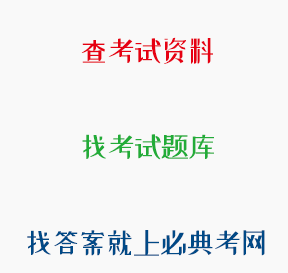[单选题]课间,小莉正在同学面前大声朗读小娟的日记,被走进教室的小娟发现,小娟找到班主任诉说此事,班主任最恰当的做法是( )。
正确答案 :A
制止小莉这种行为
解析:《中华人民共和国未成年人保护法》第三十九条规定:任何组织和个人不得披露未成年人的个人隐私,对未成年人的信件、日记、电子邮件,任何组织或者个人不得隐匿、毁弃。教师面对小莉侵犯小娟隐私的行为,班主任应该及时制止。故选择A。
[单选题]欧洲文学长廊中的四个经典人物形象,以吝啬而闻名,下列作品中不属于四大吝啬鬼登场作品的是( )。
正确答案 :B
《变色龙》
解析:《变色龙》是苏联批判现实主义作家契诃夫作品。故选择B。四大吝啬鬼作品:莎士比亚的《威尼斯商人》--夏洛克;果戈理的《死魂灵》--泼留希金;莫里哀的《悭吝人》--阿巴贡;巴尔扎克的《守财奴》(《欧也妮·葛朗台》)--葛朗台。
[单选题]教育制度的主体是( )。
正确答案 :B
学制
解析:教育制度指国民教育制度,是一个国家为实现其国民目的,从组织系统上建立起来的一切教育设施和有关规章制度。学校教育制度处于国民教育的核心和主体地位,体现了一个国家国民教育制度的实质。故选择B。A项,教育规范是调控人们教育行为的具有不同程度之普适性的指示或指示系统,而使教育规范从无到有的充分而且必要的条件是合规律与合目的。教育规范的作用就在于保障主体教育活动的合规律性与合目的性。C项,教育体制是教育机构与教育规范的结合体、统一体,它是由教育的机构体系与教育的规范体系所组成。D项,国家是指拥有共同的语言、文化、种族、血统、领土、政府或者历史的社会群体。
[单选题]下列既是整个教育工作的核心也是教育活动的依据、评判标准、出发点和归宿的是( )。
正确答案 :B
教育目的
解析:教育目的是把受教育者培养成一定社会所需要的人的总的要求,它规定把受教育者培养成什么样的人,足培养人的质量规格标准。教育目的是整个教育工作的核心,是一切教育工作的出发点和归宿。它也是全部教育活动的主题和灵魂,是教育的最高理想。
[单选题]在教学的各种备课中最为深入,最为具体的是( )。
正确答案 :C
课时备课
解析:课时备课一般包括教学内容、教学目标、教学重难点、课时安排等。课时备课是对教材内容进行详细设计的具体细节的备课,它是根据教材总的指导思想,深入到教材和教法的具体细节中去,挖掘教材,研究教法,理清思路,从知识到方法逐一设计。故选择C。
[单选题]( )是教学过程基本阶段的中心环节。
正确答案 :C
理解教材,形成概念
解析:教学过程大致分为六个阶段:①做好准备,激发动机;②感知教材,构成表象;③理解教材,形成概念;④巩固知识,增强记忆;⑤运用知识,促进迁移;⑥检测知识,获得反馈。其中理解教材,形成概念是教师给学生解疑答惑的过程,是个双向活动,只有通过"教师的教"与"学生的学"才能完成,所以被称为是整个教学过程的中心环节。
[单选题]Which of the following is true of the English sound system?
正确答案 :B
Voicing is distinctive phonetic feature
解析:雅格布逊在20世纪40年代首先提出区别特征(distinctive feature)这一想法,目的是找出一套音系的对照或对比特征,以概括语音的某些方面。比较重要的区别特征有:【辅音】【响音】【鼻音】【带声】等。【辅音】特征可以区分辅音和元音,即所有辅音都是【+辅音】,所有元音都是【一辅音】。【响音】特征用来区分所谓阻塞音(塞音、擦音及塞擦音)和响音(其他辅音和元音),即阻塞音是【一响音】,响音是【+响音】。【鼻音】和【带声】自然就是用来分别区分鼻音和带声音的特征。这些特征都是二分特征可以区分出两种情况:有该特征的和没有该特征的。综上,B选项正确。A选项,表述错误,迭气并非区别性特征。C选项,表述错误,元音的鼻音化不会产生另一个元音只是产生同化现象。D选项,表述错误,元音的长短只能区分单元音,并不能区分双元音。故选择B。
[单选题]Which of the following is not a recommended vocabulary memorizing strategy?
正确答案 :B
Rote memorization.
解析:本题考查词汇教学。题干:下列哪一项不是可推荐的词汇记忆策略?A项“情境记忆法”,B项“死记硬背”,C项“联想记忆法”,D项“词典辅助记忆法”。其中“死记硬背”不是可推荐的学习词汇的方法,故本题选B。
[单选题]________they to cut down the cost of advertising,the cost of production_______significantly
fall.
正确答案 :D
Were; would
解析:本题考查虚拟语气。句意为“如果他们降低了广告成本,生产成本就会明显下降”。表示与现在事实相反,从句谓语用动词过去式(be用were),主句谓语用would/should/could/might+动词原形;虚拟条件从句中含有were时,可省略if,并把were移至主语之前。该从句的正常语序是If they were to cut down the cost of advertising。故本题选D。
[单选题]请阅读 Passage 2,完成1~5小题。
Passage 2
IF YOU want something done,the saying goes,give it to a busy person.It is an odd way to guarantee hitting deadlines.But a paper recently published in the Journal of Consumer Research suggests it may,in fact,be true-as long as the busy person conceptualises the deadline in the right way.
Yanping Tu of the University of Chicago and Dilip Soman of the University of Toronto
examined how individuals go about both thinking about and completing tasks.Previous studies have shown that such activity progresses through four distinct phases: pre-decision,post-decision (but pre-action),action and review.It is thought that what motivates the shift from the decision-making stages to the doing-something stage is a change in mindset.
Human beings are a deliberative sort,weighing the pros and cons of future actions and remaining open to other ideas and influences.However,once a decision is taken,the mind becomes more "implemental" and focuses on the task at hand."The mindset towards 'where can I get a sandwich'," explains Ms Tu,"is more implemental than the mindset towards 'should I get a sandwich or not?'"
Ms Tu and Dr Soman advise in their paper that "the key step in getting things done is to get started." But what drives that? They believe the key that unlocks the implemental mode lies in how people categorise time.They suggest that tasks are more likely to be viewed with an implemental mindset if an imposed deadline is cognitively linked to "now" -a so-called like-the-present scenario.That might be a future date within the same month or calendar year,or pegged to an event with a familiar spot in the mind's timeline (being given a task at Christmas,say,with a deadline of Easter).Conversely,they suggest,a deadline placed outside such mental constructs (being "unlike-the-present" ) exists merely as a circle on a calendar,and as such is more likely to be considered deliberatively and then ignored until the last minute.
To flesh out this ideA.the pair carried out five sets of tests,with volunteers ranging from farmers in India to undergraduate students in Toronto.In one test,the farmers were offered a financial incentive to open a bank account and make a deposit within six months.The researchers predicted those approached in June would consider a deadline before December 31st as like-the-present.Those approached in July,by contrast,received a deadline into the next year,and were expected to think of their deadline as unlike-the-present.The distinction worked.Those with a deadline in the same year were nearly four times more likely to open the account immediately as those for whom the deadline lay in the following year.Arbitrary though calendars may be in parsing up the continuous fiow of time,humans parse their concept of time in line with them.
The effect can manifest itselfin even subtler ways.In another set of experiments,undergraduate students were given a calendar on a Wednesday and were asked to suggest an appropriate day to carry out certain tasks before the following Sunday.The trick was that some were given a calendar with all of the weekdays coloured purple,with weekends in beige (making a visual distinction between a Wednesday and the following Sunday).Others were given a calendar in which every other week,Monday to Sunday,was a solid colour (meaning that a Wednesday and the following Sunday were thus in the same week,and in the same colour).Even this minor visual cue affected how like-or unlike-the-present the respondents tended to view task priorities.
These and other bits of framing and trickery in the research support the same thesis: that making people link a future event to today triggers an implemental response,regardless of how far in the future the deadline actually lies.If the journey of l,000 miles starts with a single step,the authors might suggest that you take that step before this time next week.
What is the author's primary purpose in writing this passage?
正确答案 :A
Illustrating the key point in meeting a deadline.
解析:主旨题。本文主要阐述了按时完成事情的关键,B项不符合文意;C、D两项均是文章的某个信息,并不能全面地描述作者的意图。故本题选A。
查看原题 查看所有试题

 川公网安备 51012202001360号
川公网安备 51012202001360号